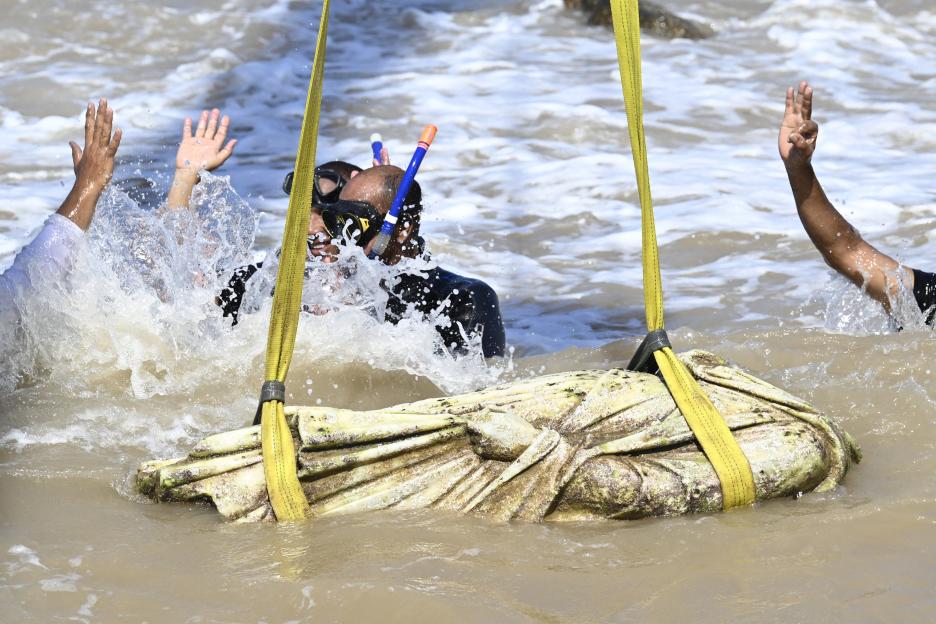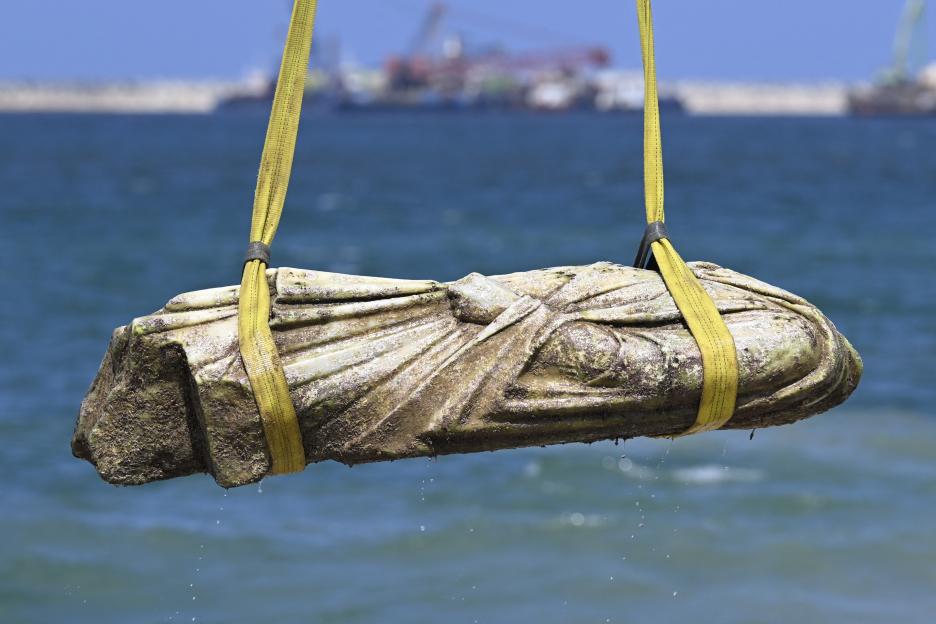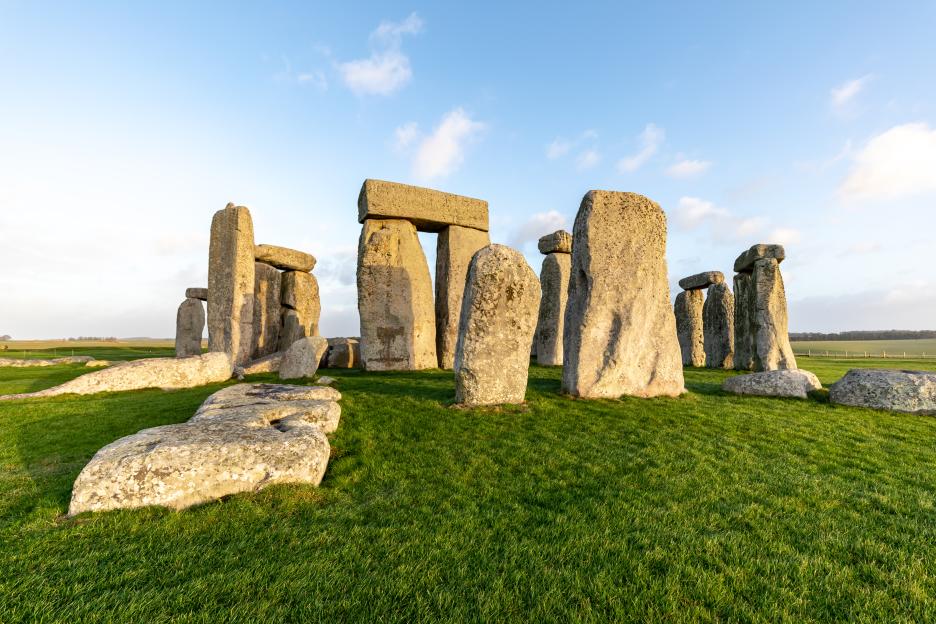REMNANTS of a 2,000-year-old city submerged under the sea have been discovered.
The recent discoveries, made off the coast of Alexandria, offer further insight into ancient Egypt .
 Divers uncovered ancient statues from what is believed to be the sunken city of Canopus
Divers uncovered ancient statues from what is believed to be the sunken city of Canopus
 A crane was used to pull up some of the statues, while most relics remain protected by an UNSECO act
A crane was used to pull up some of the statues, while most relics remain protected by an UNSECO act
The ancient city of Canopus dates back more than 2,000 years, and can be found sunken in the waters of Abu Qir bay.
Egypt has unveiled parts of a sunken city, including buildings, artefacts and an ancient dock.
According to authorities said the site may have been a prominent centre during the Ptolemaic dynasty, which ruled Egypt for nearly 300 years.
Over time, earthquakes and rising sea levels submerged the city as well as the nearby port of Heracleion.
Major operation
On Thursday, August 21, cranes hoisted statues from the depths of the sunken ruins, while divers helped.
Officials noted that only select artefacts can be lifted according to strict heritage protection rules.
“There’s a lot underwater, but what we’re able to bring up is limited, it’s only specific material according to strict criteria,” said Egypt’s tourism and antiquities minister, Sherif Fathi.
“The rest will remain part of our sunken heritage.”
Sunken heritage refers to UNESCO’s Convention on Underwater Cultural Heritage, which Egypt signed in 2001 to protect submerged archaeological sites.
The recovered items will undergo restoration before being displayed as part of a new exhibition at Alexandria’s National Museum .
Frozen in time
Meanwhile, the underwater city includes limestone buildings that may have served as places of worship, as well as residential spaces and commercial or industrial structures.
Rock-carved ponds and reservoirs for domestic water storage and fish cultivation were also uncovered.
Statues of royal figures and sphinxes from the pre-Roman era were also discovered.
A partially preserved sphinx with the cartouche of Ramses II, one of the country’s most famous and longest-ruling ancient pharaohs, remains a prominent find.
Many of the statues are missing body parts, such as a beheaded Ptolemaic figure made of granite, a marble bust of a Roman nobleman which is missing the bottom half.
A brief history of Ancient Egypt
Here's everything you need to know...
- The Ancient Egyptians were an advanced civilisation who at one point ruled over a huge portion of the globe
- The civilisation was founded about 5,000 years ago when ancient people set up villages along the River Nile
- It lasted for about 3,000 years and saw the building of complex cities centuries ahead of their time – as well as the famous Great Pyramids
- The Ancient Egyptians were experts at farming and construction
- They invented a solar calendar, and one of the world’s earliest writing systems: The hieroglyph
- The Egyptians were ruled by kings and queens called pharaohs
- Religion and the afterlife were a huge part of Ancient Egyptian culture. They had over 2,000 gods
- Pharaohs built huge elaborate tombs to be buried in, some of which were pyramids – at the time among the largest structures in the world
- The Egyptians believed in life after death, and important people’s corpses were mummified to preserve their bodies for the afterlife
- The Ancient Egyptian empire fell in 30BC due to a mix of factors, including wars with other empires and a 100-year period of drought and starvation
A 125-metre dock also featured a merchant ship, stone anchors and a harbour crane dating back to the Ptolemaic and Roman eras.
The ministry said the area was used as a harbour for small boats until the Byzantine period.
Alexandria is home to countless ancient ruins and historic treasures but is now at risk of succumbing to the same waters that claimed Canopus and Heracleion.
The coastal city is especially vulnerable to rising sea levels, sinking by more than 3mm every year.
In the United Nations’ best-case scenario, a third of Alexandria is predicted to be underwater or uninhabitable by 2050.
More on archaeology
The remains of a lost Roman city have been uncovered on a popular holiday island.
And the lost tomb of a 1,700-year-old king was uncovered in Mayan temple.
Plus, the eerie “hybrid” skull that belonged to a “half human, half neanderthal girl”.
An ancient lost city from 3,500-years-ago that played home to the oldest civilization in the Americas’ was uncovered in Peru.
And AI has deciphered a hymn on a 4,000-year-old clay tablet , which is said unlock the mystery of the ancient city of Babylon.
 The ancient statues will be restored and displayed as part of a new exhibition in Alexandria’s National Museum
The ancient statues will be restored and displayed as part of a new exhibition in Alexandria’s National Museum
 The ancient city is completely submerged in the waters of Abu Qir bay in Alexandria, Egypt
The ancient city is completely submerged in the waters of Abu Qir bay in Alexandria, Egypt







